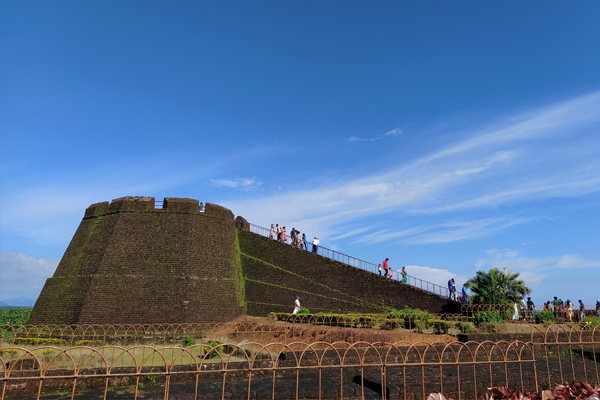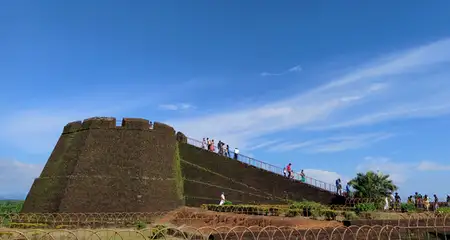Kerala is not just about tranquil backwaters, picturesque beaches, gently swaying coconut trees, Ayurvedic massages and exotic spices. It can impress you with its historical gems too. One such gem is Bekal Fort. Nestled in the lap of nature at the confluence of land and sea, Bekal Fort is a delight for both history buffs and nature lovers. This massive and impressive keyhole-shaped structure of laterite is famous for being the largest and best-preserved fort in Kerala. It sits proudly on a steep hill and offers breathtaking views of the surrounding Bekal Fort Beach and the Arabian Sea. The grand architecture and serene location by the sea make Bekal Fort a popular attraction among tourists. And considering its historical relevance, the fort has been entrusted to the care of the Archaeological Survey of India.
Bekal Fort is about 68 km from Mangalore and 15 km from Kasaragod. If Indian history, historical structures and natural beauty fascinate you, a trip to Bekal Fort will leave you mesmerised. Here’s some information about Bekal Fort timings, entry fees and more to help you plan your trip better.
Bekal Fort, Bekal Information
|
Location |
Kasaragod Road, Beside Bekal Fort Railway Station, Bekal |
|
Timings |
8:00 AM to 6:00 PM |
|
Entry Fee |
INR 20 per person |
|
Commissioned By |
King Shivappa Nayak of Bednore |
|
Year of Establishment |
1650 AD |
|
Best Time to Visit |
October to March |
|
Time Required |
2-3 hours |
|
Material Used |
Laterite and red sandstone |
|
Entrance |
Zigzag entrance |
Bekal Fort ticket prices and timings are subject to change without prior notice. Hence, it is advisable to call at the fort before planning a trip to avoid any confusion later. Bekal Fort contact number is +91 467 2310700.
Bekal Fort: History
Bekal Fort boasts a rich history as it was the stronghold of many kings, sultans as well as the British.
While the fort was reportedly constructed by King Shivappa Nayak, there are several other theories associated with its creation. It is believed that Bekal Fort existed during the rule of Chirakkal or Kolathiri Rajas as such forts were built in the olden days for defence purposes. It was later invaded and rebuilt by King Shivappa Nayak of Bednore. It is also said that the Nayaks brought the Koteyar/Ramakshatriya community to Bekal and other places in the Kasaragod district to strengthen the fort.
There was a long struggle between the Kolathiries and Nayaks to recapture and rule the area. However, this battle came to end in 1763 when the Sultan of Mysore, Hyder Ali, captured Bekal. The fort was later used as an important military station by Tipu Sultan and his army during his expedition to capture Malabar. However, after the death of Tipu Sultan in the Fourth Anglo-Mysore War in 1799, the fort fell in the hands of the British East India Company. The British also used Bekal Fort for their administrative and military affairs. In 1956, the State Reorganisation Act was passed, and Kasaragod became a part of Kerala.
Bekal Fort: Today
Bekal Fort is a popular tourist destination these days. In fact, the stunning surroundings make it a popular shooting location among movie and ad filmmakers as well. The well-manicured gardens and beautiful pathways add to the charm of this historic structure and make it one of the most amazing places to visit in Kerala.
Bekal Fort: Architecture
Bekal Fort sits at an impressive height of 130 feet above sea level and boasts an area of 40 acres. This lofty keyhole-shaped structure was mainly built for defence purposes as it has no palaces or mansions inside. The zigzag entrance, 12-meter-high walls, tactically planned openings on the outer walls, and trenches around the entire fort area speak volumes of the impressive defence strategy that the past rulers adopted.
The focal point of the fort is the Observation Tower with peepholes. The tower was built by Tipu Sultan, again for defence reasons. The fort also houses a temple dedicated to Lord Hanuman, a mosque, and a water tank.
A notable aspect of the fort’s architecture is the outstanding utilisation of defence technology. The peepholes on the outer walls were designed brilliantly to protect the fort from naval attacks. The topmost holes could aim at the enemies who were at a distance, the middle ones were meant to fight those who were nearer to the fort, and the lowermost holes were for those enemies who were closest to the fort. The underground tunnels and a sea bastion are other important parts of the fort’s structure.
Things to See at Bekal Fort
- Anjaneya Temple: The entrance of the fort has a temple dedicated to Lord Hanuman. The shrine is believed to be as old as the fort itself. It was renovated recently and is a major attraction among tourists and devotees.
- Mosque: You can also see a mosque built by Tipu Sultan just outside Bekal Fort.
- Observation Tower: The tower is situated in the middle of the fort and can be reached by climbing a flight of stairs. It has a height of 30 feet and a circumference of about 80 feet. The tower offers amazing views of the rocky shoreline of the Arabian Sea and the green landscape on the other side.
- Underground passages: The fort also features many underground tunnels leading to the outside from different directions. Two of these underground passages are still intact.
- Sea bastion: The sea bastion on the rocky projection of the fort offers stunning views of the beach and the Arabian Sea.
- Sunset: The fort is a popular vantage point for enjoying clear views of the sunset.
How to Reach Bekal Fort
The town is well connected by air, rail and road, so you can choose a suitable mode of transportation to reach Bekal. If you are taking a flight, Mangaluru International Airport is 71 km from the fort. Bekal has a train station but with limited connectivity. So, it is better to reach Kanhagad (9 km away) or Kasaragod (18 km away) railway station and hire a taxi from there to cover the distance. Bekal enjoys good road connectivity, so you can also take a private vehicle, taxi or bus to reach the fort from nearby towns and cities.
Lesser-Known Facts about Bekal Fort
Here are a few interesting things that not many know about Bekal Fort:
- Unlike most other forts in India, Bekal Fort has no remains of mansions, palaces or any other buildings. This implies that the fort was built solely for defence.
- The fort was built as a defence post to avert threats and attacks from the sea.
- The fort also has a magazine room with weapons and ammunition. However, it is closed to the public.
Nearby attractions
From sun-kissed beaches and delightful backwaters to majestic forts and temples, Bekal is home to various tourist hotspots. Some must-visit attractions near the fort are:
- Bekal Fort Beach (120 m)
- Bekal Beach (1 km)
- Bekal Beach Park (1 km)
- Pallikare Beach (2 km)
- Trikkannad Tryambakeshwara Temple (3 km)
- Kottappara Monsoon Waterfalls (5 km)
- Sree Madiyan Kolam Kshethrapalaka Temple (8 km)
- Kanhangad Beach (10 km)
- Chandragiri Fort (10 km)
- Hosdurg Fort (12 km)
- Chembirika Beach (14 km)
Besides exploring the beaches and monuments, there are many other things to do in Bekal. If you are a foodie, you must try the local restaurants in Bekal. The town is known for a range of delectable dishes, such as Puttu, Idiyappam, Iddali, fried bananas, Payasam and Toddy. Shopping in Bekal is another fun option for tourists looking to buy local products and souvenirs. The town is known for its handicrafts, wood carvings and coconut products.
All in all, boasting a glorious past and standing tall, Bekal Fort is a must-visit. The massive fort will take you back in time and the picturesque surroundings will fill you with peace and happiness. Whenever you plan a trip to Bekal, remember to book flight or train tickets and hotel rooms well in advance to avoid any problems later. This way, you can easily choose from different kinds of hotels in Bekal and pick one that suits your taste and budget.




























